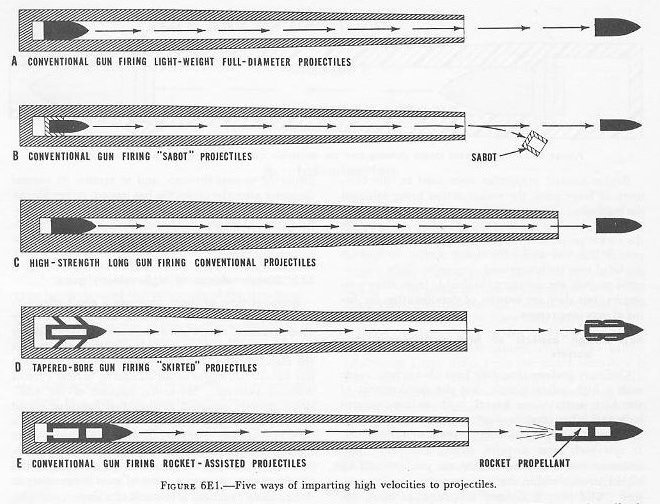| NAVAL ORDNANCE AND GUNNERY, VOLUME 1 CHAPTER 6 GUN BARRELS AND INTERIOR BALLISTICS |
| HOME INDEX Chapter 6 Gun Barrels and Interior Ballistics A. Introduction B. Elements of gun design and maintenance C. Interior ballistics D. Erosion E. New developments in gun design |
| E. New Developments in Gun Design 6E1. Attainment of high muzzle velocity Defense against modern high-speed aircraft is largely a fire control problem. Firing is at a predicted future position of the target, and the less time the projectile spends in the air between the muzzle and the objective, the less time hostile aircraft have for defensive maneuvering. Higher muzzle velocities are not the whole answer, but do contribute to the simplification of the problem. Of the several means of achieving higher muzzle velocities, the following either were used in action in World War II or were experimented with. See figure 6E1. |
 |
 |
| Lightweight projectiles fired from conventional guns attained muzzle velocity of about 4,000 feet per second as compared with 2,700 for the standard projectiles. Air resistance, however, so quickly retarded this type of projectile that it was of slight use at the longer ranges prevailing in naval warfare. It was used with great effect ashore in antitank warfare, where ranges were shorter. Subcaliber projectiles fired from conventional guns lightened the projectile and, at the same time, presented less surface for air resistance. This is a more slender projectile fitted with a lightweight bushing called a sabot which fits the gun bore and drops away after the projectile leaves the muzzle. The German army achieved muzzle velocities above 5,000 fs with guns as large as 11-inch and also fired sabot projectiles from 90-mm antiaircraft guns. This too has disadvantages for sea use, as the discarded sabot is dangerous to nearby friendly ships. Conventional projectiles fired from high-strength or extra long guns can attain a velocity limited only by the amount of pressure that the gun can withstand and by the amount of pressure that can be developed with available types of powder. Such guns would be heavier and require considerably more space aboard ship than guns which impart conventional velocities to standard projectiles. Tapered-bore guns firing “skirted” projectiles have many of the advantages of the sabot without the danger to friendly personnel. This subcaliber projectile is equipped with flanges which furnish a gas seal and which are squeezed inward by a tapered reduction in the size of the bore toward the muzzle. There is some loss of accuracy and a smaller projectile is fired, but these effects are more than compensated for by the reduced time of flight. The Germans used such “squeeze-bore” guns in sizes from 20- to 75-mm and attained 4,700 fs muzzle velocities with them. Rocket-assisted projectiles were used by the Germans in large guns, the rocket action being initiated during flight. The range of this projectile was greatly increased, but the space in the projectile occupied by the rocket propellant reduced the pay-load of high explosive that the projectile could carry. It appears doubtful that rocket-assisted projectiles could consistently provide the accuracy obtainable from other projectiles, but they are worthy of consideration for firing at very long ranges. |
| 6E2. Design aspects of high-performance gun barrels Ordinary-performance guns have always been made with a high safety margin, but the development of the high-performance barrel, with its concomitant bulk and other complications, required a re-study of gun design, so as to cut safety margin to a minimum. It was with some surprise, during this study, that ordnance engineers learned that the projectile set up higher stresses within the gun than the powder pressure. The liner is obliged to stretch to allow the projectile to pass through, and to resume its normal diameter after the projectile has passed, rather like an ostrich swallowing an orange. See figure 6E2. Entirely new methods of stress analysis had to be developed to evaluate the influence of this previously unrecognized factor. 6E3. Disadvantages of high-velocity guns. Reduced time of flight increases a gun’s effectiveness, but, especially for shipboard use, there are other considerations. Such guns must necessarily be larger and heavier than conventional guns, so much so that the installation of one high-velocity gun on a present day naval craft might mean sacrificing several guns of ordinary velocity. Moreover, because of the additional powder required, ammunition handling would be complicated and it would be harder to maintain a high rate of fire. Further, these guns wear out more quickly than those designed for ordinary-velocity projectiles. A careful evaluation of all advantages and disadvantages of various types of guns is necessary in determining optimum armament of a ship. |